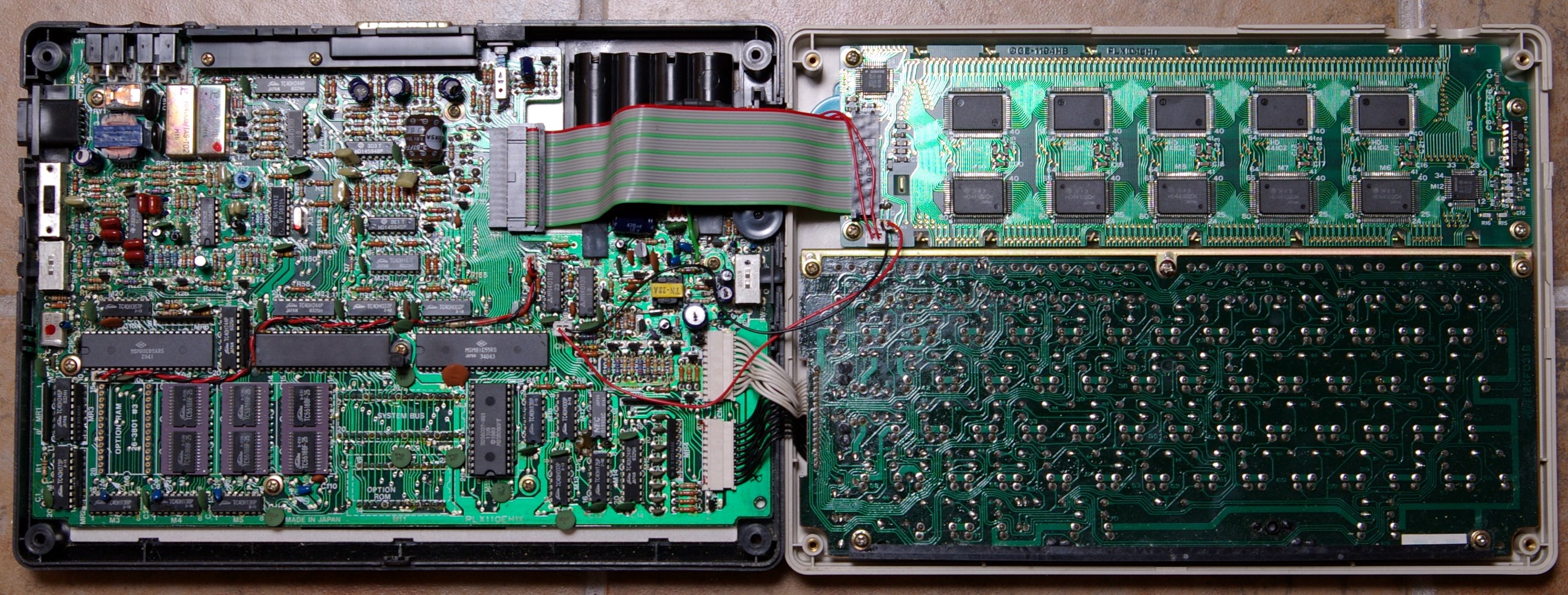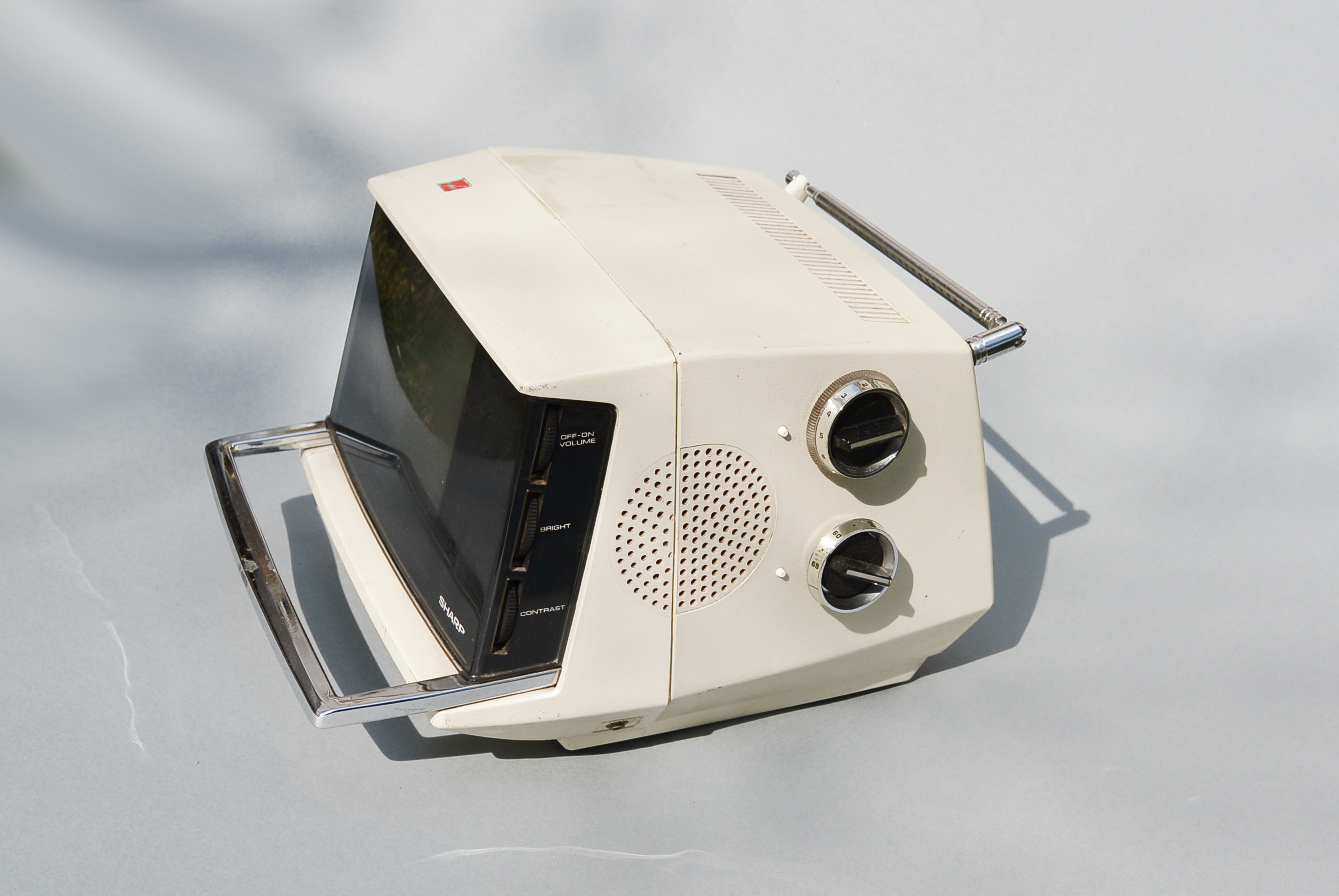|
Tandy Model 100
The TRS-80 Model 100 is a portable computer introduced in April 26th, 1983. It is one of the first notebook-style computers, featuring a keyboard and liquid crystal display, in a battery-powered package roughly the size and shape of a notepad or large book. It was made by Kyocera, and originally sold in Japan as the Kyotronic 85. Although a slow seller for Kyocera, the rights to the machine were purchased by Tandy Corporation. The computer was sold through Radio Shack stores in the United States and Canada and affiliated dealers in other countries. It became one of the company's most popular models, with over 6 million units sold worldwide. The Olivetti M-10 and the NEC PC-8201 and PC-8300 were also built on the same Kyocera platform, with some design and hardware differences. It was originally marketed as a ''Micro Executive Work Station'' (MEWS), although the term did not catch on and was eventually dropped. Specifications * Processor: 8-bit Oki 80C85, CMOS, * Memory: ... [...More Info...] [...Related Items...] OR: [Wikipedia] [Google] [Baidu] |
Kyocera
is a Japanese multinational ceramics and electronics manufacturer headquartered in Kyoto, Japan. It was founded as in 1959 by Kazuo Inamori and renamed in 1982. It manufactures industrial ceramics, solar power generating systems, telecommunications equipment, office document imaging equipment, electronic components, semiconductor packages, cutting tools, and components for medical and dental implant systems. History Origins to 2000 Kyocera's original product was a ceramic insulator known as a "kelcima" for use in television picture tubes. The company quickly adapted its technologies to produce an expanding range of ceramic components for electronic and structural applications. In the 1960s, as the NASA space program, the birth of Silicon Valley and the advancement of computer technology created demand for semiconductor integrated circuits (ICs), Kyocera developed ceramic semiconductor packages that remain among its core product lines today. In the mid-1970s, Kyocera began e ... [...More Info...] [...Related Items...] OR: [Wikipedia] [Google] [Baidu] |
Modem
A modulator-demodulator or modem is a computer hardware device that converts data from a digital format into a format suitable for an analog transmission medium such as telephone or radio. A modem transmits data by Modulation#Digital modulation methods, modulating one or more carrier wave signals to encode digital information, while the receiver Demodulation, demodulates the signal to recreate the original digital information. The goal is to produce a Signal (electronics), signal that can be transmitted easily and decoded reliably. Modems can be used with almost any means of transmitting analog signals, from light-emitting diodes to radio. Early modems were devices that used audible sounds suitable for transmission over traditional telephone systems and leased lines. These generally operated at 110 or 300 bits per second (bit/s), and the connection between devices was normally manual, using an attached telephone handset. By the 1970s, higher speeds of 1,200 and 2,400 ... [...More Info...] [...Related Items...] OR: [Wikipedia] [Google] [Baidu] |
Plain Old Telephone Service
Plain old telephone service (POTS), or plain ordinary telephone system, is a retronym for voice-grade telephone service employing analog signal transmission over copper loops. POTS was the standard service offering from telephone companies from 1876 until 1988 in the United States when the Integrated Services Digital Network (ISDN) Basic Rate Interface (BRI) was introduced, followed by cellular telephone systems, and voice over IP (VoIP). POTS remains the basic form of residential and small business service connection to the telephone network in many parts of the world. The term reflects the technology that has been available since the introduction of the public telephone system in the late 19th century, in a form mostly unchanged despite the introduction of Touch-Tone dialing, electronic telephone exchanges and fiber-optic communication into the public switched telephone network (PSTN). Characteristics POTS is characterized by several aspects: *Bi-directional ( full duplex) co ... [...More Info...] [...Related Items...] OR: [Wikipedia] [Google] [Baidu] |
Baud
In telecommunication and electronics, baud (; symbol: Bd) is a common unit of measurement of symbol rate, which is one of the components that determine the speed of communication over a data channel. It is the unit for symbol rate or modulation rate in symbols per second or pulses per second. It is the number of distinct symbol changes (signalling events) made to the transmission medium per second in a digitally modulated signal or a bd rate line code. Baud is related to ''gross bit rate'', which can be expressed in bits per second. If there are precisely two symbols in the system (typically 0 and 1), then baud and bit per second (bit/s) are equivalent. Naming The baud unit is named after Émile Baudot, the inventor of the Baudot code for telegraphy, and is represented according to the rules for SI units. That is, the first letter of its symbol is uppercase (Bd), but when the unit is spelled out, it should be written in lowercase (baud) except when it begins a senten ... [...More Info...] [...Related Items...] OR: [Wikipedia] [Google] [Baidu] |
Key Rollover
Key rollover is the ability of a computer keyboard to correctly handle several simultaneous keystrokes. A keyboard with ''n''-key rollover (NKRO) can correctly detect input from each key on the keyboard at the same time, regardless of how many other keys are also being pressed. Keyboards that lack full rollover will register an incorrect keystroke when certain combinations of keys are pressed simultaneously. Rollover has applications for stenotype, electronic music keyboards, gaming, and touch-typing generally. Keyboard usage During normal typing on a conventional computer keyboard, only one key is usually pressed at any given time, then released before the next key is pressed. However, this is not always the case. When using modifier keys such as Shift or Control, the user intentionally holds the modifier key(s) while pressing and releasing another key. * Rapid typists may also sometimes inadvertently press a key before releasing the previous one. Certain unusual forms of keyboa ... [...More Info...] [...Related Items...] OR: [Wikipedia] [Google] [Baidu] |
RC Oscillator
Linear electronic oscillator circuits, which generate a sinusoidal output signal, are composed of an amplifier and a frequency selective element, a filter. A linear oscillator circuit which uses an RC network, a combination of resistors and capacitors, for its frequency selective part is called an RC oscillator. Description RC oscillators are a type of feedback oscillator; they consist of an amplifying device, a transistor, vacuum tube, or op-amp, with some of its output energy fed back into its input through a network of resistors and capacitors, an RC network, to achieve positive feedback, causing it to generate an oscillating sinusoidal voltage. They are used to produce lower frequencies, mostly audio frequencies, in such applications as audio signal generators and electronic musical instruments. At radio frequencies, another type of feedback oscillator, the LC oscillator is used, but at frequencies below 100 kHz the size of the inductors and capacitors needed for t ... [...More Info...] [...Related Items...] OR: [Wikipedia] [Google] [Baidu] |
Sharp Electronics
is a Japanese multinational corporation that designs and manufactures electronics, electronic products, headquartered in Sakai-ku, Sakai, Sakai-ku, Sakai, Osaka Prefecture. Since 2016 it has been majority owned by the Taiwan-based Foxconn Group. Sharp employs more than 50,000 people worldwide. The company was founded in September 1912 in Tokyo and takes its name from one of its founder's first Ever-Sharp mechanical pencil, which was invented by Tokuji Hayakawa in 1915. History Early years 1912–1945 In 1912, Tokuji Hayakawa founded a metal workshop in Tokyo. The first of his many inventions was a snap buckle named 'Tokubijo'. Another of his inventions was the Ever-Ready Sharp mechanical pencil in 1915. The product became one of the first internationally available mechanical pencils (while concurrent US design replaced it soon and became a modern type), and due to this big success the Sharp Corporation derived its name from it. After the pencil business was destroyed by the 19 ... [...More Info...] [...Related Items...] OR: [Wikipedia] [Google] [Baidu] |
Backlighting
A backlight is a form of illumination used in liquid crystal displays (LCDs). As LCDs do not produce light by themselves—unlike, for example, cathode ray tube (CRT), plasma (PDP) or OLED displays—they need illumination ( ambient light or a special light source) to produce a visible image. Backlights illuminate the LCD from the side or back of the display panel, unlike frontlights, which are placed in front of the LCD. Backlights are used in small displays to increase readability in low light conditions such as in wristwatches, and are used in smart phones, computer displays and LCD televisions to produce light in a manner similar to a CRT display. A review of some early backlighting schemes for LCDs is given in a report ''Engineering and Technology History'' by Peter J. Wild. Simple types of LCDs such as in pocket calculators are built without an internal light source, requiring external light sources to convey the display image to the user. Most LCD screens, however, are b ... [...More Info...] [...Related Items...] OR: [Wikipedia] [Google] [Baidu] |
Twisted Nematic Field Effect
The twisted nematic effect (''TN-effect'') was a main technology breakthrough that made LCDs practical. Unlike earlier displays, TN-cells did not require a current to flow for operation and used low operating voltages suitable for use with batteries. The introduction of TN-effect displays led to their rapid expansion in the display field, quickly pushing out other common technologies like monolithic LEDs and CRTs for most electronics. By the 1990s, TN-effect LCDs were largely universal in portable electronics, although since then, many applications of LCDs adopted alternatives to the TN-effect such as in-plane switching (IPS) or vertical alignment (VA). Many monochrome alphanumerical displays without picture information still use TN LCDs. TN displays benefit from fast pixel response times and less smearing than other LCD display technology, but suffer from poor color reproduction and limited viewing angles, especially in the vertical direction. Colors will shift, potentially t ... [...More Info...] [...Related Items...] OR: [Wikipedia] [Google] [Baidu] |
Static RAM
Static random-access memory (static RAM or SRAM) is a type of random-access memory (RAM) that uses latching circuitry (flip-flop) to store each bit. SRAM is volatile memory; data is lost when power is removed. The term ''static'' differentiates SRAM from DRAM (''dynamic'' random-access memory) — SRAM will hold its data permanently in the presence of power, while data in DRAM decays in seconds and thus must be periodically refreshed. SRAM is faster than DRAM but it is more expensive in terms of silicon area and cost; it is typically used for the cache and internal registers of a CPU while DRAM is used for a computer's main memory. History Semiconductor bipolar SRAM was invented in 1963 by Robert Norman at Fairchild Semiconductor. MOS SRAM was invented in 1964 by John Schmidt at Fairchild Semiconductor. It was a 64-bit MOS p-channel SRAM. The SRAM was the main driver behind any new CMOS-based technology fabrication process since 1959 when CMOS was invented. In 1965, ... [...More Info...] [...Related Items...] OR: [Wikipedia] [Google] [Baidu] |
Read-only Memory
Read-only memory (ROM) is a type of non-volatile memory used in computers and other electronic devices. Data stored in ROM cannot be electronically modified after the manufacture of the memory device. Read-only memory is useful for storing software that is rarely changed during the life of the system, also known as firmware. Software applications (like video games) for programmable devices can be distributed as plug-in cartridges containing ROM. Strictly speaking, ''read-only memory'' refers to memory that is hard-wired, such as diode matrix or a mask ROM integrated circuit (IC), which cannot be electronically changed after manufacture. Although discrete circuits can be altered in principle, through the addition of bodge wires and/or the removal or replacement of components, ICs cannot. Correction of errors, or updates to the software, require new devices to be manufactured and to replace the installed device. Floating-gate ROM semiconductor memory in the form of erasab ... [...More Info...] [...Related Items...] OR: [Wikipedia] [Google] [Baidu] |






